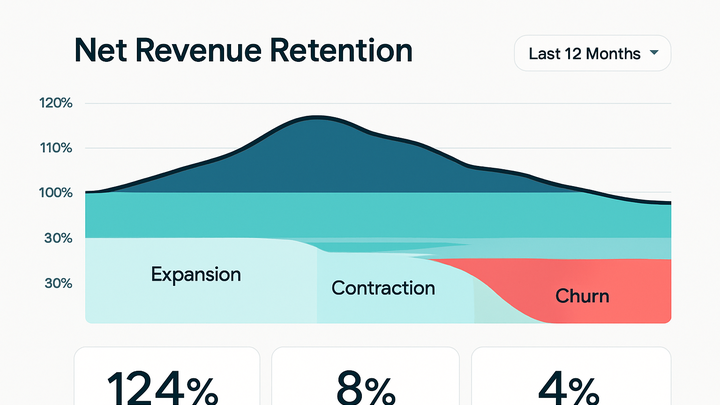Published on 2025-06-22T08:30:17Z
What is Net Revenue Retention? Examples and Calculations
In subscription-based businesses and analytics, Net Revenue Retention (NRR) measures how revenue from existing customers changes over time, accounting for expansions, contractions, and churn. It is expressed as a percentage, indicating whether a company’s current customer base is growing or shrinking in revenue contribution. NRR is a key performance indicator in SaaS and analytics industries because it reflects customer satisfaction, product value, and upsell success. For instance, tools like PlainSignal’s cookie-free analytics and Google Analytics 4 (GA4) can track subscription events and usage patterns to feed into NRR calculations. By analyzing cohort revenue data in GA4 or custom dashboards in PlainSignal, teams can monitor the drivers of NRR and implement strategies to improve customer retention. A healthy NRR above 100% signifies that expansion revenue exceeds losses, enabling sustainable growth and reduced reliance on new customer acquisition.
Net revenue retention
Percentage of revenue retained from existing customers, factoring in expansions, contractions, and churn.
Why Net Revenue Retention Matters
Net Revenue Retention (NRR) provides insight into a company’s ability to generate revenue growth from its existing customer base. It combines factors such as upgrades, downgrades, and churn to show whether an organization is expanding or contracting within its installed base. A high NRR (>100%) indicates that expansion revenue outpaces churn, signaling healthy growth. Investors and executives rely on NRR as a key performance indicator in SaaS, subscription, and analytics industries. It also helps teams prioritize customer success initiatives and product improvements.
-
Business health indicator
NRR serves as a composite metric reflecting overall customer base health. It factors in expansions and contractions, showing net revenue trends.
-
Investor and board metric
NRR is often cited in fundraising, board reports, and benchmarks to demonstrate sustainable revenue growth.
-
Growth predictor
A high NRR suggests that a company can grow revenue without acquiring new customers, reducing acquisition costs.
How to Calculate Net Revenue Retention
Net Revenue Retention is calculated by dividing the revenue at the end of a period, net of expansions, contractions, and churn, by the revenue at the start of the period. The formula helps finance and analytics teams quantify retention-driven growth. Typically measured over a 12-month period, but can also be calculated monthly or quarterly to track shorter-term trends. Understanding each component ensures accurate reporting and actionable insights.
-
Starting monthly recurring revenue (mrr)
The MRR at the beginning of the period, serving as the baseline for NRR calculation.
-
Expansion mrr
Additional revenue from existing customers upgrading or purchasing add-ons during the period.
-
Contraction mrr
Revenue loss from existing customers downgrading their plans or reducing usage.
-
Churned mrr
Revenue lost due to customers canceling their subscriptions entirely.
-
Nrr formula and example
Formula: NRR = (Starting MRR + Expansion MRR - Contraction MRR - Churned MRR) / Starting MRR × 100. Example: If Starting MRR = \(100k, Expansion = \)15k, Contraction = \(5k, Churn = \)10k: NRR = (100k + 15k - 5k - 10k) / 100k = 1.0 or 100%.
Tracking Net Revenue Retention with Analytics Tools
Analytics platforms can help track and visualize NRR components through revenue analytics, cohort analysis, and custom dashboards. Tools like PlainSignal and GA4 can collect and process subscription events, enabling teams to calculate NRR automatically. By integrating event tracking, teams can build real-time reports and identify trends driving retention or churn.
-
Integrating PlainSignal for nrr
Use PlainSignal’s cookie-free simple analytics to capture user revenue events. Insert the tracking snippet to your site to record subscription upgrades and cancellations.
-
Tracking code
<script defer data-do="yourwebsitedomain.com" data-id="0GQV1xmtzQQ" data-api="//eu.plainsignal.com" src="//cdn.plainsignal.com/plainsignal-min.js"></script>
-
-
Setting up nrr in GA4
Configure custom events in GA4 for subscription_start, subscription_upgrade, subscription_downgrade, and subscription_cancel. Use Explorations and BigQuery to calculate NRR over desired intervals.
-
Cohort analysis
Perform cohort analysis to segment customers by acquisition month. Track revenue per cohort over time to derive NRR trends and identify areas for improvement.
Strategies to Improve Net Revenue Retention
Improving NRR involves driving expansions, reducing downgrades, and preventing churn. Employ targeted customer success, personalized upsell campaigns, and product enhancements. Regularly monitor NRR components and set real-time alerts in analytics tools to react quickly to revenue decay.
-
Personalized upsell campaigns
Use in-app messaging and email journeys to promote add-ons or higher-tier plans based on usage patterns.
-
Proactive customer success
Identify at-risk customers using usage data. Conduct regular check-ins and offer training to maximize product value and reduce churn risk.
-
Feedback-driven product improvements
Collect user feedback to prioritize features that boost engagement and justify upgrades.
-
Targeted retention offers
Offer discounts or incentives to customers showing signs of churn to retain revenue and maintain a high NRR.
